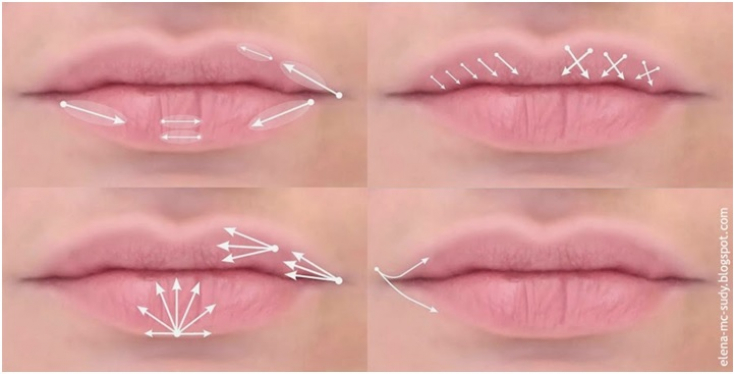Perioral area – the near-oral part of the face, which is subjected to cosmetic procedures due to the deterioration of the appearance of the skin in this area. Often, to increase the cosmetic effect in this area, contouring, lipofilling, botulinum toxin procedures are used.
There are several techniques for injecting filler into the lips. Read about it and how much to inject for maximum effect.
estet-portal.com talked to a dermatologist, cosmetologist, owner of the clinic «Estimed» (Uzhgorod), co-owner and scientific director of the ESTY DERM organization, member of the expert council of Allergan, Merz, Emet, Hyalual Inga Voloshina-Andrashko.
Distinctive characteristics of filler techniques in the perioral region

I.V-A.: There are two main filler techniques:
- Linear retrograde (used in the perioral region to correct Cupid's arch, columna philtrum, lip contour):
- The "Parisian lips" technique involves serial parallel percutaneous punctures, therefore it is characterized by high trauma;
- Fan technique allows you to minimize the number of punctures, but evenly distribute the drug in the tissues, injecting hyaluronic acid in several directions using 1 access point.
- bolus or volumetric.
Do not forget that the most painful moment for the patient during the injection of the filler — skin puncture.
Is the volume of injection correction unlimited and how to stop in time
I.V-A.: Lips have a limited volume, they cannot increase with a single injection of a large amount of hyaluronic acid without losing quality.
In case of overstretching, part of the material gets into non-target zones: lateral sections (when injected under the red border of the lips, the effect of Masha Malinovskaya may curl), white border of the lips (Injection of dense material into the lip rim may result in a Cat Whiskers effect).
How to rejuvenate your face by correcting the shape of the lips
I am deeply convinced that at the stage of the initial visit of the patient for the purpose of injectable lip contouring, the maximum that we can afford to inject is 1 ml of hyaluronic acid preparation, in in some cases I inject as little as 0.55 ml.
When choosing the volume, you should take into account the wishes of the patient, full awareness and perception of information about post-procedure edema, hematomas and the duration of the rehabilitation period.
In my practice I use validated Merz scales — these are the only scales most commonly used, thanks to which you can see the degree of lip enlargement, depending on the amount of the injected drug, as well as predict and plan the effect of contouring.
Follow us on Instagram
Strong points when choosing a hyaluronic acid preparation
I.V-A.: When choosing a hyaluronic acid product, I consider:
- Manufacturer company status
By this point, I mean conducting multicenter studies, organizing a serious scientific base, having a representative office of the company in all countries of the world and, accordingly, using the drug, the presence of a huge number of highly qualified speakers who talk about the drug in the world arenas of aesthetic medicine and patients who did not stay disappointed.
- Availability of double packaging
I choose preparations that are available in 0.55 and 1.0 ml volumes because the ability to use the filler in the amount I need for initial correction and after-correction makes my work easier and promotes compliance.
- Presence of lidocaine
The lips and perioral area are among the most sensitive areas.
For some patients, the issue of painlessness of the procedure is a top priority and prevailing.
I work without topical anesthesia, because high quality drugs with anesthetic allow leveling the problem of pain with a high degree of safety. My patients experience pain on the first few piercings, then the anesthetic effect kicks in, allowing the patient to relax and, in a sense, enjoy. The presence of lidocaine also helps to avoid the feeling of fullness, burning in the post-procedure period.
Thank you for staying with estet-portal.com. Read other interesting articles in the "Cosmetology" section. You might be interested in A Quick Guide to Injectable Filler Techniques







Add a comment